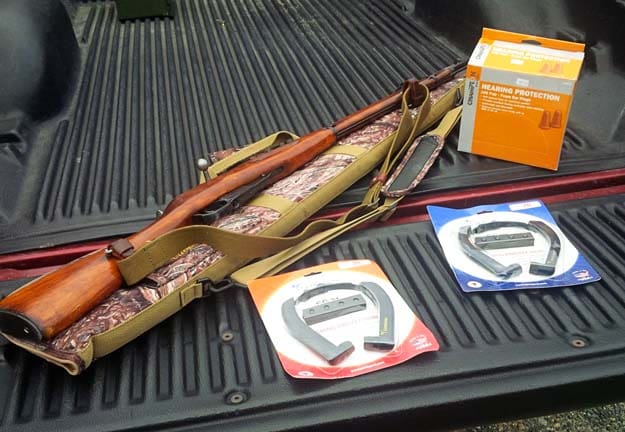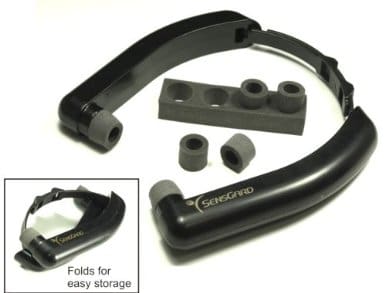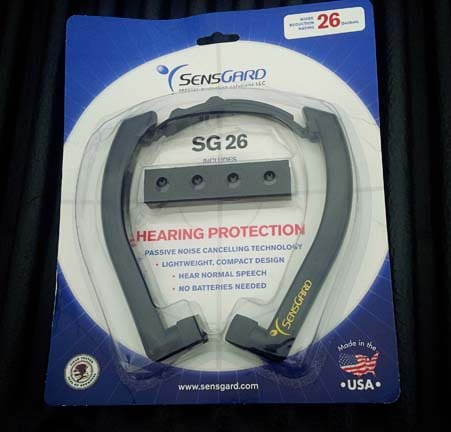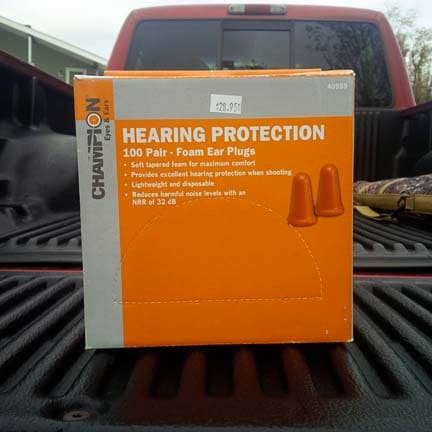By Craig S.
Rhode Island is at its best in October; Newport has its Oktoberfest and pumpkin flavored beers come out of the woodworks. Stressed out college students are eagerly waiting midterm grades. And finally, muzzleloader and shotgun deer season is just around the corner. And that has me trying out some hearing protection for shooting. Yes, this is a review of hearing protection products…three in fact. If you’re looking for a sexy girl with an AR, a passionate rant about the right to keep and bear arms or some harebrained home defense strategy like Joe Biden’s “Just shoot the ceiling twice with a double barreled shotgun” plan, please press the back button. Otherwise, come on in . . .
Hearing protection, along with eye protection is always something that tends to get little airtime. Some people think the products out there just don’t change over time. That’s partially correct. The market hasn’t evolved at the rate guns and ammo have, but hearing protection has became much more advanced in recent years. And ear pro is extremely important. Every public or private gun range requires it, at least the ones I know, and every shooter and bystander should plug their ears at all times when in the presence of gunfire.
The three products covered here are Champion Hearing Protection Foam Ear Plugs (what I call “five cent throwaways”) and two from SensGard; the SG26 (noise reduction rating of 26 decibels) and SG31 (if you guessed that the noise reduction rating of these babies is 31 decibels, you’re correct). I’ve been using the Champion ear plugs for the last year and a half and I have previously felt that they were better than adequate when it came to any firearm that’s .30 caliber or smaller rifle (.30-06, 7.62x54r, .303), a non-magnum handgun, and the standard 12-gauge shotgun with 2.75” shotshells. The SensGard plugs were new to me.
To test this troika of sound prevention, I needed something relatively loud. Not something that would shake the snow off a pine tree by the power of its Thu’um, but not something that sounds like an unruly squirrel rustling in the leaves. The answer was simple; a M91/30, the 7.62x54r bargain basement deal Mosin that won the Great Patriotic War. In my experience, my M91/30 is a little louder than a .303 SMLE No. 1 MkIII*, much louder than a 7.62×39 AK and is noticeably quieter than .30-06 deer rifle with a 24” barrel. It’s right in the middle in terms of loudness when it comes to .30 caliber rifles and most People of the Gun own some sort of .30 caliber rifle; anything above that is a head turner. The ammo I was using was 1950s production Bulgarian surplus; brass casing, Berdan primed, corrosive and fireball inducing in the right conditions. I ended up touching off about 70 shots for this review.
The first product I tried was the SG26 (about $25). They’re similar to headphones; they adjust by pushing the two halves either closer together or farther apart. When I tried the SG26 on before arriving at the range, I noticed that loud sounds, like wind get converted into a sort of white noise. The foam part that goes into the ear go into the ear canal a little, but they don’t fully plug or block it.
The sound of the M91/30 and the ARs around me was much different than what I was used to. The rifles sounded more like they were being shot indoors rather than outdoors. However, the SG26s do provide adequate hearing protection. That is, when they actually stay on your head. Both the SG26 and the SG31 simply wouldn’t stay on my noggin. They tended to work loose, fall forward into my face and sometimes the Mosin’s recoil simply blew them out of my ears.
The prolonged recoil and noise didn’t affect me until about 30 shots into the SG26s. They got loose occasionally, but after 30 shots, these were so loose and shaky that they were completely ineffective. Having to put a loaded rifle down to repeatedly adjust hearing protection is unacceptable and a potential way to get in trouble with a range officer. Luckily, no one noticed or mentioned my issues with the SensGards.
To their credit, both of the SensGard models I tried are adequate in my opinion for light shooting, such as rimfire, hunting or emptying out a carry pistol’s magazine. But they were completely inadequate for sustained centerfire shooting, especially from a standing position. These things would simply not stay on my head. SensGard claims on the package that these allow the user to engage in conversation and hear other sounds, i.e. the sounds of animals or people talking. After about 35 shots with the SG26s, I went back to my truck and inserted the old reliable Champion ear plugs.
The biggest benefit (and downfall) of traditional ear plugs is how they’re inserted into the ear. Roll – don’t squish – the narrow part of the plugs, lick them, then stick them into the ear canal. If done properly, the stoppels will expand inside the ear canal and form a solid barrier against sound. In my case, the plugs go so far in and form such a good seal that I always end up pulling earwax out of my head when I remove them. Speaking of, the earplugs’ other downside is that they are not easy to remove and re-insert. They also inhibit conversations and ambient sounds. I’m very satisfied with Champion earplugs for shooting at the range, but they simply block out too many sounds to be effective for hunting.
The SG31s (about $32) were a joke. I fired a dozen shots with them and after each one, I had to readjust them in my ear. The level of hearing protection doesn’t seem any better than the SG26s. Five decibels simply isn’t enough of an improvement to warrant another model in my experience when dealing with firearms. Firearms simply are too loud to notice a difference in five decibels.
Overall, I give the SensGard products a C+. They do reduce the sounds of gunfire and they allow the user to hear ambient sounds. However, for my head, they wouldn’t stay on and that’s too much of a distraction and safety hazard to be effective enough for me. I was lucky that no one had a REAL rifle at the range – something like a .300 Winchester Magnum or a .338 Lapua Magnum. So I’ll stick to my Champion plugs, but understand that earplugs won’t work for everyone. The right answer, in short, is to find out what works for you. Shoot well and shoot safely.









The simple answer here is that if you want to be able to hear game sounds, have conversations at the range, etc then you are going to spend at least $75-$100 for the least expensive but still quality set of ear muffs like the Howard Leight Impact Sport muffs, which work very well outdoors. Indoors, I would not recommend using them as they are not rated for the sound range you will get on an indoor range.
+1 on the Howard Leight Impact Sports. I just used a pair this weekend for deer and dove hunting. I could hear everything around me, but no ringing after 80+ shots of 12 ga and 30-30.
My only disappointment with Howard Leight Impact ear-pro is that the ear cushions harden after about two years and don’t isolate your ears after that. I just found a replacement parts kit at Optics Planet, and ordered it. I hope it fits!
Thanks for the review. Someone was actually using a pair of these at the Appleseed I attended last weekend, but that was only .22LR, and they were too far away from me to hear any complaints.
BTW, your “five cent throwaways” are actually about five times that price, based on the sticker in the photo. Not that it makes any real difference.
Thanks, I enjoyed contributing to the blog. They come out to be 29 cents per plug, however “twenty-nine cent throwaways” simply does not ring when saying it or reading it 🙂
As a hearing conservationist, I’ve tried SensGards, and have mixed feelings about them; I won’t knock the devices entirely, but personally, I’m not crazy about them. My personal preference is soft foam earplugs in combination with earmuffs, especially when shooting under a metal cover. Just to comment on a couple of other points however- I won’t tell you not to lick your earplugs, but I’d caution that it’s a bit… unhygienic, and when training others, I don’t recommend they do so. Also, the difference between 26 and 31dB doesn’t seem like a lot, but an understanding of the exchange rate (5 dB increase/decrease in protection = safe exposure time is doubled/halved, respectively, per OSHA, or 3 dB using ACGIH standards), the difference becomes significant, very quickly! As for the ease in removing them, try this trick- give them a gentle twist before you remove them. You should feel the seal release, and you can then remove the earplugs without popping them like champagne corks. For people who have difficulty grasping the earplugs to remove them, many come in stringed versions that may make it easier to get a grip on them, or with posts in them for easier grasping. Just my .02 worth :).
Thanks for the info. I figured the 5 db increase had something to do with OHSA. I just didn’t notice a difference at all when I was at the range.
As for licking and sticking, it just helps me get a better seal with the plugs. Its not the cleanliest habit. Everyone I know doesn’t use ear plugs, and I can understand why. But they work for me.
3M has ‘real’ earplugs (meaning that they go in the ear canal) with ‘acoustic chambers’, like the Sensguard. The fact the Sensguards are reported to fall off is not good, especially not with other people shooting in your surroundings. They have a model with two ways of putting it in, one fully blocking, the other one using the acoustic chamber. The model I have sits nicely in the ear and has a pushpin to block the chamber (so it’ll be like a traditional plug) and open it pushes loud sounds down really well, while only attenuating normal level sounds by something like 7dB. That means I can talk normally to people and hear stuff on the range, while at the same time the booms get nicely adjusted. I was surprised with how well they work.
Thank you for this review. Personal protective equipment (PPE) is (or should be) such an important part of the firearm experience that I’ve always been surprised by how little press it gets.
I would love to see a future review and/or comparison of some of the excellent electronic earmuffs that are currently available. With prices of certain models exceeding $300 I just haven’t been able to bring myself to purchase a set (yet).
There are two components to hearing: air and bone. Plugs block air conduction but do nothing for bone. The temporal bone through which the ear canal comes out has a projection just behind and below the ear canal. It’s called the mastoid process an can be felt through the skin. It’s full of air chambers that act as resonance chambers and it shares a wall with the middle ear. All this aids in conduction of sound. Ear muff type of conduction covers the mastoid and thereby further reduces perceived noise.
I hate mutts. They get in the way of the cheek weld.
I’d like to see an integrated hearing protection system that goes in the canal and around the ear to cover the mastoid but does not get in the way of buttstocks AND can be worn with glasses.
If the SensGards actually went into the ear canal, like the plugs, and they stayed on my head, I think they would fit your bill nicely. Because of their thinness, the SensGards don’t interfere with shooting glasses or a cheek weld. In fact, my best shooting that day was done with the SG26s. But after awhile, they simply kept falling off.
Dr Vino, try something like this: http://www.grainger.com/Grainger/3M-Hearing-Band-3NZE7?Pid=search You should be able to get them from many suppliers; I just used Grainger because I knew they carry them. They don’t go *over* the ear, but they are adjustable, and I’ve found they seem to stay in place well. Two possible drawbacks are that some people find the tension necessary to keep them in place a little uncomfortable ( I didn’t) and they’re slightly porous, so if it’s hot, they get squishy with sweat- bring along some fresh dry earpods to swap out!
As for earmuffs, I’ve dound some Browning Buckmark collapsible earmuffs at Academy for around $20. Fairly high noise rating, and they have cutouts onthe bottom half of the earmuff cupps that make cheek weld a little easier. Hope that’s useful.
OOOOOOOOOOOOOOOOOOOOOO……………
The HearinG Band looks interesting.
Thanks for the heads up.
Any time!
23 db is not enough protection from gunfire.
Dr. Vino, you might like this: http://www.earplugstore.com/marilyn-mance-ear-muffers.html
I tried them and they work well. But they are awkward to apply (I needed a mirror) — although I’ve only used them once..
I have tried the SG31’s and they were horrible. I was shooting a 9mm handgun on an indoor range, and I had to quit early with a ringing in my ears. I threw them in my junk box and never used them again.
it sounds kinda gross, but I reuse my foam ear plugs. I’ve got loud neighbors and use ear plugs every night to drown them/their dogs out. Some brands are better than others, but some are good for 2 weeks’ worth of consecutive use. That at least amortizes the cost.
For shooting, +1 on the Howard Leight Impact Sport (around $40 from Amazon). If i’m shooting a lot of centerfire at the indoor range, it’s wise to double up and use foamies under the muffs.
Why is reusing ear plugs gross? I do it, as a matter of fact I carry ear plugs in my pocket (in a small bag) at all times.
Some plugs can be reused, usually the flanged type, but if so, it will say so on the packaging. Soap and water to clean after every use, pat dry, inspect for damage, and they could last a week or two.
Generally speaking, foam shouldn’t be reused because they’re slightly porous, and will hold dirt, oils,etc. which can’t be cleaned out of them adequately. That leads to 2 problems- putting something back into your ears that have been culturing who knows what since the last use can lead to infections, and the foam won’t retain the same resiliency once it’s got crud in it, so it won’t give you the same fit and protection that it did when it was fresh out of the package.
I’m not sure I’d recommend licking earplugs before insertion. It sounds like a good way to get an ear infection. In fact, I usually recommend this video when talking about how to properly insert ear plugs.
http://www.youtube.com/watch?v=oEObOaHp6Bg
Its a habit I picked up from a welder. I used to have a problem with keeping the plugs in my ear canal, and after I started licking them, they stick quite well. Not a full blown slobbering, more like licking a rolled cigarette. YMMV however, as always.
I’ve found that good plugs work best for me. And there are huge differences between different foam plugs. The ones just shaped like a simple cylinder (usually yellow foam) are worthless to me, and pretty uncomfortable.
It was interesting, was at an outdoor range last weekend and with just good foam plugs I was fine…except for when someone would shoot .40S&W. People were shooting 9mm, .45, 5.56, .308, .357mag, .50AE…none of it bothered me, but the .40 was painful. I’m guessing it has to relate to the mastoid process mentioned in a previous comment, but the .40 was the ONLY round being shot that bothered me.
What about electronic ear muffs?
I have been looking for ear muffs with some features I would like:
– Electronic (or whatever else that can dampen loud noise while not dampening low sounds).
– Being able to listen to music (connect to MP3 or phone).
– Noise Reduction Rating of 30db.
– Large muffs (I have large ears which make most ear pro uncomfortable).
I cant seem to find any ear muffs with all these characteristics.
I bought a pair of these awhile back-
http://www.earplugstore.com/silnatrubear.html
I’ve worn them under a metal shelter with four people shooting pistols at the same time, and felt no discomfort. They come with a plastic case, and I carry them with me at all times.
“Not something that would shake the snow off a pine tree by the power of its Thu’um, but not something that sounds like an unruly squirrel rustling in the leaves.”
FUS ROH DAH!!!
Ha! I wondered if anyone else caught the Skyrim reference. Nice.
I like the surefire ear plugs for shotgun and handgun then use my peltor PTL for rifle and both for large brake equipped rifles.
My buddy has the MSA sordins and I got to admit they’re nice. $300 nice that’s up to you.
Not to sound cheap or anything, but you can reuse foam plugs several times. Wash with clothes, they come out of dryer like new. You can do this 6 times and get the price per use down to a real nickel. Proper hygeine helps. Keeping your ears nearly waxless is easy. Swab outer ears with tissue paper daily after your shower. The thin wax film in the outer ear is absorbed by tissue paper. Use 3 fresh patches of tissue in the outer ear, then _gently_ swab ear canal with Q-tip, rotation helps. If you do this daily, your ear plugs won’t gross anyone out.
Not being critical, but the cost of foam earplugs is less than one round of ammo for most guns. Seems like a great price to me to save something as important as hearing.
Indoor pistols I usually use both foam, and ear muffs. Either alone doesn’t seem to be enough, but combined it’s great.
I’m not sure if it’s the exact same model or brand name, but I have a headset a lot like the SG 26, and it works great.
Part of the trick to getting it to stay in place is rotating the whole thing from the back of your head up to the top as you put the foam earpieces in. That gives you a decent seal that keeps sound from simply bypassing a loose gasket. And mine have a little foam strip where the headpiece rests on top of your head, which helps keep the whole thing stable.
I don’t do any indoor shooting, but for the shooting I do — a couple hours worth of 9mm & .45 pistols, .22’s, and a 30-30 rifle — they do a great job. They cut out too much low-level sound to wear if quiet sounds matter, but they let you hear a lot more than the expanding foam plugs. And they’re much, MUCH more convenient and easy to use than bulky earmuffs or those annoying foam plugs.
It’s a good idea to go overkill on hearing protection because any pain you notice from loud noises is damage and too late to fix.
For now I’m just going to stick with my Peltor electronic muffs. They stay on my head no matter how much running and moving I’m doing with them on, do a nice job keeping out the super loud while letting in and amplifying speech. I find them enormously useful on the range and in training sessions where I’m trying to hear the instructor’s commands over the sound of AR fire, etc.
Comments are closed.